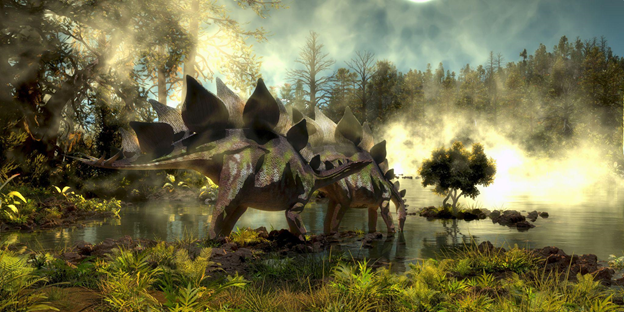Experience the Most Complete Stegosaurus Fossil – Up Close and Personal
The American Museum of Natural History is currently showcasing a true paleontological treasure: the most complete Stegosaurus fossil thought to have ever been discovered.
It’s not just making a cameo or a stopover from another collection, either. This one is new. Discovered in 2022 in the Morrison Formation just outside of (aptly-named) Dinosaur, Colorado, the 150 million year-old Stegosaurus fossil, which has been named Apex, is remarkably complete.
Over 254 of 320 bone elements were recovered from the formation, with missing pieces being filled in with 3D-printed pieces and sculpted facsimiles.
The Stegosaurus fossil has been positioned in a defensive posture, with its signature spiked tail upraised, and is on exhibit at the entrance to the Gilder Center in the Kenneth C. Griffin Exploration Atrium.
The exhibit is now open and included with any admission – it’s something not to be missed, for lovers of natural history, paleobiology, or just dinosaurs and fossils in general.
Prep Yourself: Unique Stegosaurus Facts
Arguably one of the most recognizable dinosaur specimens in history (perhaps behind Tyrannosaurus rex and species of Triceratops), Stegosaurus is an iconic genus.
Here are some facts to ponder or pique your interest before your visit to the Apex exhibit:
- Stegosaurus is a genus, not a species. Currently there are three recognized species in the genus, which are Stegosaurus stenops, ungulatus, and sulcatus. One of the Apex exhibit’s main focuses, in collaboration with scientists from the Museum’s Division of Paleontology, will be determining the species to which Apex belongs.
- Stegosaurus is not the only genus of dinosaur notable for the armored plates on its back. Others include Kentrosaurus and Huayangosaurus.
- Stegosaurus means “roofed lizard” in Greek, a nod to the signature plates that covered its back.
- Stegosaurus had an infamously tiny brain – just the size of a walnut. That’s amazingly small for a dinosaur of this size, which was believed to have weighed in the area of 1.5 to 5.5 tons. Theories prevail that the reason for the animal’s small brain size was that it didn’t need much cognitive power to chase the plants it ate!
- The infamous spiked tail of a Stegosaurus actually has an informal name – a “thagomizer,’ named after a 1982 “Far Side” cartoon that featured it. The generally accepted theory for the function of the spiked tail was as a weapon against predators. This theory is supported by evidence that nearly 10% of specimen tail spikes appear to have sustained some form or other of injury.
- Paleontologists are still not quite sure what the biological role of Stegosaurus’ back plates really was. Theories include that the plates were used for communication, to deter threats, or even to dissipate heat. There are small grooves in the sides of the plates, along which small blood vessels may once have run, the presence of which somewhat supports the theory of heat dissipation – although this is still contested.
- Stegosaurus didn’t just eat herbaceous matter – it also ate stones. These small pebbles and stones were called gastroliths (stomach stones) and were theorized to aid the dinosaur in digesting its coarse, woody diet through mechanical means.
- Because of its longer rear legs and comparatively short front legs, early models of Stegosaurus suggested that it was bipedal. However, it is now generally accepted that it was most likely a quadruped.
- Early scientists that studied Stegosaurus were so befuddled by the small size of its brain that there was a hypothesis that it may have had a second brain in a large recess in its posterior spinal column, which may have helped control the animal’s reflexes. However, the feature is also present in birds, where it serves as a “glycogen body” that stores nutrients to supply the central nervous system, and not as a second brain. It may have served the same role in Stegosaurus.
- While the genus Stegosaurus is the most famous of dinosaurs known as “stegosaurs” for their back plates, there are many other genera that were similar to it – and most of them were from Asia, not North America.
- Stegosaurus likely had a beak like a bird, or perhaps more like a turtle. This theory is supported by the position of the tips of both the upper and lower jaws, as well as by the absence of front teeth; this dinosaur’s teeth fossils occur only at the sides of the mouth. This anatomy may indicate that stegosaurus was an obligate browser of low-growing vegetation, not entirely unlike the large ungulates of the modern era.

Stop By Our Shop and Leave with a Dinosaur Teeth and Fossils of Your Own
If all this talk of the new Apex Stegosaurus fossil has reignited your passion for paleontology, visit our shop when you plan your trip and leave with a dinosaur claw fossil of your own before you’re out of town. We are right across Columbus Avenue from the American Museum of Natural History – so you won’t need to make any diversions! Stop by our shop on the way home, take a close look through our collection of dinosaur teeth and fossils – among other specimens. There’s something in our collection for you. Maybe you can’t have a Stegosaurus plate, but you can leave with an authentic fossilized memento to commemorate the visit!
